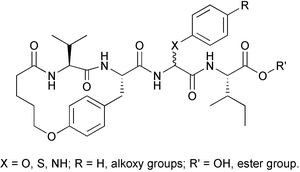New β-strand macrocyclic peptidomimetic analogues containing α-(O-, S- or NH-)aryl substituted glycine residues: synthesis, chemical and enzymatic properties
Abstract
In so much as bis-macrocyclic

* Corresponding authors
a INSERM U-382, Developmental Biology Institute of Marseille (CNRS-INSERM-Université de la Méditerranée- AP Marseille), Laboratoire de Chimie Biomoléculaire, Faculté des Sciences de Luminy, case 907, 13288 Marseille Cedex 09, France
In so much as bis-macrocyclic

 Please wait while we load your content...
Something went wrong. Try again?
Please wait while we load your content...
Something went wrong. Try again?
G. Quéléver, F. Bihel and J. Kraus, Org. Biomol. Chem., 2003, 1, 1676 DOI: 10.1039/B211644H
To request permission to reproduce material from this article, please go to the Copyright Clearance Center request page.
If you are an author contributing to an RSC publication, you do not need to request permission provided correct acknowledgement is given.
If you are the author of this article, you do not need to request permission to reproduce figures and diagrams provided correct acknowledgement is given. If you want to reproduce the whole article in a third-party publication (excluding your thesis/dissertation for which permission is not required) please go to the Copyright Clearance Center request page.
Read more about how to correctly acknowledge RSC content.
 Fetching data from CrossRef.
Fetching data from CrossRef.
This may take some time to load.
Loading related content
